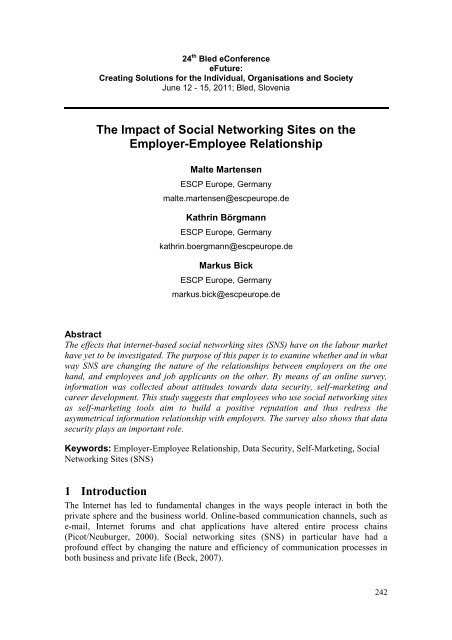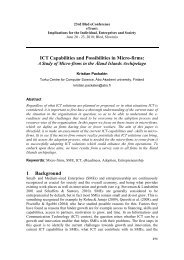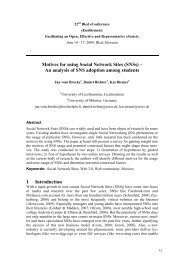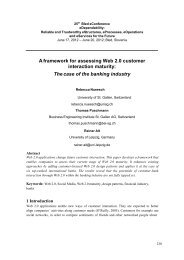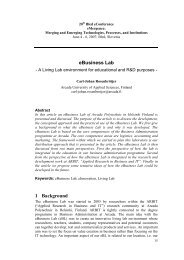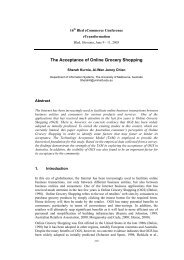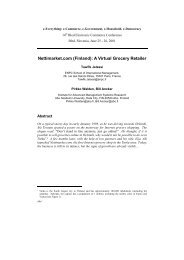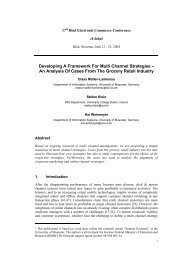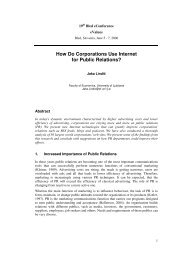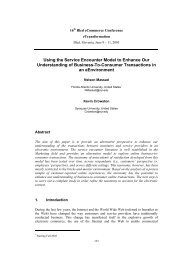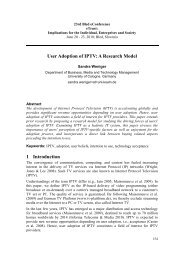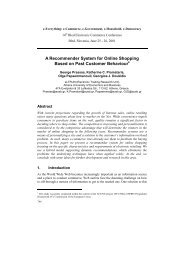The Impact of Social Networking Sites on the Employer-Employee ...
The Impact of Social Networking Sites on the Employer-Employee ...
The Impact of Social Networking Sites on the Employer-Employee ...
Create successful ePaper yourself
Turn your PDF publications into a flip-book with our unique Google optimized e-Paper software.
24 th Bled eC<strong>on</strong>ference<br />
eFuture:<br />
Creating Soluti<strong>on</strong>s for <strong>the</strong> Individual, Organisati<strong>on</strong>s and Society<br />
June 12 - 15, 2011; Bled, Slovenia<br />
<str<strong>on</strong>g>The</str<strong>on</strong>g> <str<strong>on</strong>g>Impact</str<strong>on</strong>g> <str<strong>on</strong>g>of</str<strong>on</strong>g> <str<strong>on</strong>g>Social</str<strong>on</strong>g> <str<strong>on</strong>g>Networking</str<strong>on</strong>g> <str<strong>on</strong>g>Sites</str<strong>on</strong>g> <strong>on</strong> <strong>the</strong><br />
<strong>Employer</strong>-<strong>Employee</strong> Relati<strong>on</strong>ship<br />
Malte Martensen<br />
ESCP Europe, Germany<br />
malte.martensen@escpeurope.de<br />
Kathrin Börgmann<br />
ESCP Europe, Germany<br />
kathrin.boergmann@escpeurope.de<br />
Markus Bick<br />
ESCP Europe, Germany<br />
markus.bick@escpeurope.de<br />
Abstract<br />
<str<strong>on</strong>g>The</str<strong>on</strong>g> effects that internet-based social networking sites (SNS) have <strong>on</strong> <strong>the</strong> labour market<br />
have yet to be investigated. <str<strong>on</strong>g>The</str<strong>on</strong>g> purpose <str<strong>on</strong>g>of</str<strong>on</strong>g> this paper is to examine whe<strong>the</strong>r and in what<br />
way SNS are changing <strong>the</strong> nature <str<strong>on</strong>g>of</str<strong>on</strong>g> <strong>the</strong> relati<strong>on</strong>ships between employers <strong>on</strong> <strong>the</strong> <strong>on</strong>e<br />
hand, and employees and job applicants <strong>on</strong> <strong>the</strong> o<strong>the</strong>r. By means <str<strong>on</strong>g>of</str<strong>on</strong>g> an <strong>on</strong>line survey,<br />
informati<strong>on</strong> was collected about attitudes towards data security, self-marketing and<br />
career development. This study suggests that employees who use social networking sites<br />
as self-marketing tools aim to build a positive reputati<strong>on</strong> and thus redress <strong>the</strong><br />
asymmetrical informati<strong>on</strong> relati<strong>on</strong>ship with employers. <str<strong>on</strong>g>The</str<strong>on</strong>g> survey also shows that data<br />
security plays an important role.<br />
Keywords: <strong>Employer</strong>-<strong>Employee</strong> Relati<strong>on</strong>ship, Data Security, Self-Marketing, <str<strong>on</strong>g>Social</str<strong>on</strong>g><br />
<str<strong>on</strong>g>Networking</str<strong>on</strong>g> <str<strong>on</strong>g>Sites</str<strong>on</strong>g> (SNS)<br />
1 Introducti<strong>on</strong><br />
<str<strong>on</strong>g>The</str<strong>on</strong>g> Internet has led to fundamental changes in <strong>the</strong> ways people interact in both <strong>the</strong><br />
private sphere and <strong>the</strong> business world. Online-based communicati<strong>on</strong> channels, such as<br />
e-mail, Internet forums and chat applicati<strong>on</strong>s have altered entire process chains<br />
(Picot/Neuburger, 2000). <str<strong>on</strong>g>Social</str<strong>on</strong>g> networking sites (SNS) in particular have had a<br />
pr<str<strong>on</strong>g>of</str<strong>on</strong>g>ound effect by changing <strong>the</strong> nature and efficiency <str<strong>on</strong>g>of</str<strong>on</strong>g> communicati<strong>on</strong> processes in<br />
both business and private life (Beck, 2007).<br />
242
<str<strong>on</strong>g>The</str<strong>on</strong>g> <str<strong>on</strong>g>Impact</str<strong>on</strong>g> <str<strong>on</strong>g>of</str<strong>on</strong>g> <str<strong>on</strong>g>Social</str<strong>on</strong>g> <str<strong>on</strong>g>Networking</str<strong>on</strong>g> <str<strong>on</strong>g>Sites</str<strong>on</strong>g> <strong>on</strong> <strong>the</strong> <strong>Employer</strong>-<strong>Employee</strong> Relati<strong>on</strong>ship<br />
Platforms such as XING (http://www.xing.com) and Facebook (http://www.facebook.com)<br />
are increasing in popularity and gain attenti<strong>on</strong> in print, televisi<strong>on</strong> and internet media.<br />
However, <strong>the</strong>re has been little empirical research <strong>on</strong> whe<strong>the</strong>r and in what way SNS are<br />
changing <strong>the</strong> relati<strong>on</strong>ship between employers, employees and job applicants, or indeed<br />
how <strong>the</strong>se relati<strong>on</strong>ships have already changed (Boyd/Ellis<strong>on</strong>, 2008). Linked to this are<br />
questi<strong>on</strong>s such as: do job applicants and employees follow certain objectives in terms <str<strong>on</strong>g>of</str<strong>on</strong>g><br />
self-marketing? If so, what are <strong>the</strong>y? Is informati<strong>on</strong> actively disclosed and sought? How<br />
important are c<strong>on</strong>cerns about data security?<br />
Being based <strong>on</strong> an empirical study <strong>the</strong> aim <str<strong>on</strong>g>of</str<strong>on</strong>g> this paper is to build a c<strong>on</strong>sistent picture<br />
<str<strong>on</strong>g>of</str<strong>on</strong>g> <strong>the</strong> influence <str<strong>on</strong>g>of</str<strong>on</strong>g> SNS <strong>on</strong> business communicati<strong>on</strong> channels. By means <str<strong>on</strong>g>of</str<strong>on</strong>g> an <strong>on</strong>line<br />
survey <str<strong>on</strong>g>of</str<strong>on</strong>g> XING and Facebook users data in <strong>the</strong> key areas <str<strong>on</strong>g>of</str<strong>on</strong>g> data security, selfmarketing<br />
and <strong>the</strong> applicati<strong>on</strong> <str<strong>on</strong>g>of</str<strong>on</strong>g> SNS for career development purposes was collected.<br />
<str<strong>on</strong>g>The</str<strong>on</strong>g> perspective <str<strong>on</strong>g>of</str<strong>on</strong>g> <strong>the</strong> employee and/or job applicant is in <strong>the</strong> primary focus.<br />
In this paper we first outline <strong>the</strong> <strong>the</strong>oretical framework <str<strong>on</strong>g>of</str<strong>on</strong>g> <strong>the</strong> subsequent empirical<br />
study. Next, research model and methodology are explained. Following this, <strong>the</strong> results<br />
<str<strong>on</strong>g>of</str<strong>on</strong>g> <strong>the</strong> study are presented and <strong>the</strong>n discussed. <str<strong>on</strong>g>The</str<strong>on</strong>g> article c<strong>on</strong>cludes with a syn<strong>the</strong>sis and<br />
we outline some opportunities for fur<strong>the</strong>r research.<br />
2 <str<strong>on</strong>g>The</str<strong>on</strong>g>oretical Framework<br />
2.1 Definiti<strong>on</strong> <str<strong>on</strong>g>of</str<strong>on</strong>g> Terms and Characteristics<br />
<str<strong>on</strong>g>Social</str<strong>on</strong>g> networks can be defined as a web <str<strong>on</strong>g>of</str<strong>on</strong>g> social relati<strong>on</strong>s in which individual, group,<br />
collective or corporate actors are embedded (Jansen, 2010). According to this, <strong>the</strong> term<br />
social network also encompasses distant c<strong>on</strong>tacts, with multiple levels <str<strong>on</strong>g>of</str<strong>on</strong>g> interc<strong>on</strong>nected<br />
members who do not necessarily know each o<strong>the</strong>r.<br />
SNS create a special virtual platform through which social relati<strong>on</strong>s can be represented<br />
and enacted from a user-centric point <str<strong>on</strong>g>of</str<strong>on</strong>g> view. <str<strong>on</strong>g>The</str<strong>on</strong>g>y can be defined as ‘[...] web-based<br />
services that allow individuals to (1) c<strong>on</strong>struct a public or semi-public pr<str<strong>on</strong>g>of</str<strong>on</strong>g>ile within a<br />
bounded system, (2) articulate a list <str<strong>on</strong>g>of</str<strong>on</strong>g> o<strong>the</strong>r users with whom <strong>the</strong>y share a c<strong>on</strong>necti<strong>on</strong>,<br />
and (3) view and traverse <strong>the</strong>ir list <str<strong>on</strong>g>of</str<strong>on</strong>g> c<strong>on</strong>necti<strong>on</strong>s and those made by o<strong>the</strong>rs within <strong>the</strong><br />
system’ (Boyd/Ellis<strong>on</strong>, 2008). <str<strong>on</strong>g>The</str<strong>on</strong>g> novelty <str<strong>on</strong>g>of</str<strong>on</strong>g> SNS is not that individual users can get to<br />
know strangers, but ra<strong>the</strong>r that existing c<strong>on</strong>tacts in <strong>the</strong> n<strong>on</strong>-virtual world can be<br />
displayed in lists, and exchanged with o<strong>the</strong>r members/users (Haythornthwaite, 2005).<br />
This visualizati<strong>on</strong> <str<strong>on</strong>g>of</str<strong>on</strong>g> c<strong>on</strong>tacts and pers<strong>on</strong>al networks can be explained in terms <str<strong>on</strong>g>of</str<strong>on</strong>g> <strong>the</strong><br />
Signaling <str<strong>on</strong>g>The</str<strong>on</strong>g>ory (Spence, 1973), which describes <strong>the</strong> main motivati<strong>on</strong>s for using SNS.<br />
<str<strong>on</strong>g>The</str<strong>on</strong>g>se motivati<strong>on</strong>s can be generalized into two primary goals: (1) <strong>the</strong> desire to verify<br />
<strong>on</strong>e’s identity to <strong>the</strong> outside world, and (2) <strong>the</strong> desire to ensure cooperati<strong>on</strong> in pers<strong>on</strong>al<br />
networks (D<strong>on</strong>ath/Boyd, 2004).<br />
SNS can be divided into two main groups: business networks and leisure networks. In<br />
business networks, <strong>the</strong> main focus is <strong>on</strong> pr<str<strong>on</strong>g>of</str<strong>on</strong>g>essi<strong>on</strong>al interests; establishing and<br />
maintaining business relati<strong>on</strong>ships am<strong>on</strong>g colleagues and business partners is <strong>the</strong><br />
primary aim. Pr<str<strong>on</strong>g>of</str<strong>on</strong>g>iles largely c<strong>on</strong>sist <str<strong>on</strong>g>of</str<strong>on</strong>g> labour market-relevant data such as <strong>the</strong> name<br />
and locati<strong>on</strong> <str<strong>on</strong>g>of</str<strong>on</strong>g> employers, work experience and qualificati<strong>on</strong>s. Leisure networks, by<br />
c<strong>on</strong>trast, are used primarily in <strong>the</strong> private sphere focusing <strong>on</strong> <strong>the</strong> maintenance <str<strong>on</strong>g>of</str<strong>on</strong>g><br />
existing friendships. With over 500 milli<strong>on</strong> members, Facebook is c<strong>on</strong>sidered <strong>the</strong><br />
243
Malte Martensen, Kathrin Börgmann, Markus Bick<br />
world’s largest leisure network (Washingt<strong>on</strong>/Miller, 2009; Facebook, 2011). LinkedIn<br />
has some 90 milli<strong>on</strong> users, making it <strong>the</strong> most popular business network in <strong>the</strong> world,<br />
while in German-speaking countries <strong>the</strong> business network XING (10 milli<strong>on</strong> members)<br />
dominates (Dutta/Fraser, 2009; LinkedIn, 2011; XING, 2011).<br />
2.2 Labour Market-Related Relati<strong>on</strong>ships in <str<strong>on</strong>g>Social</str<strong>on</strong>g> <str<strong>on</strong>g>Networking</str<strong>on</strong>g> <str<strong>on</strong>g>Sites</str<strong>on</strong>g><br />
<str<strong>on</strong>g>The</str<strong>on</strong>g>re is a special kind <str<strong>on</strong>g>of</str<strong>on</strong>g> relati<strong>on</strong>ship between employers and employees and between<br />
employers and potential employees, i.e. job applicants. In this relati<strong>on</strong>ship, demands and<br />
obligati<strong>on</strong>s are diametrically opposed. <str<strong>on</strong>g>The</str<strong>on</strong>g> employer’s demands in terms <str<strong>on</strong>g>of</str<strong>on</strong>g> work<br />
performance (which can simultaneously be seen as <strong>the</strong> employee’s obligati<strong>on</strong>) are<br />
balanced against <strong>the</strong> employee’s demands for remunerati<strong>on</strong> (i.e. wage and salary), for<br />
job security, self-realizati<strong>on</strong>, participati<strong>on</strong>, as well as technical and social c<strong>on</strong>diti<strong>on</strong>s<br />
(Dlugos et al., 1987).<br />
<str<strong>on</strong>g>The</str<strong>on</strong>g>se c<strong>on</strong>flicting interests can be interpreted in terms <str<strong>on</strong>g>of</str<strong>on</strong>g> New Instituti<strong>on</strong>al Ec<strong>on</strong>omics.<br />
Following <strong>on</strong> from Principal-Agent <str<strong>on</strong>g>The</str<strong>on</strong>g>ory, <strong>the</strong>re is a relati<strong>on</strong>ship between principal<br />
(employer) and agent (employee) in which <strong>the</strong> employee has scope for opportunistic<br />
behaviour based <strong>on</strong> <strong>the</strong> asymmetrical distributi<strong>on</strong> <str<strong>on</strong>g>of</str<strong>on</strong>g> informati<strong>on</strong> and a general<br />
uncertainty about future c<strong>on</strong>diti<strong>on</strong>s (Jensen/Meckling, 1976).<br />
For <strong>the</strong> present study, Hidden Characteristics, i.e. <strong>the</strong> principal’s (employer’s) ability to<br />
view <strong>the</strong> hidden or private characteristics <str<strong>on</strong>g>of</str<strong>on</strong>g> <strong>the</strong> agent (employee) in advance <str<strong>on</strong>g>of</str<strong>on</strong>g> making<br />
a (labour) c<strong>on</strong>tract, are particularly important. <str<strong>on</strong>g>The</str<strong>on</strong>g>se characteristics can lead to<br />
additi<strong>on</strong>al costs or inhibit <strong>the</strong> making <str<strong>on</strong>g>of</str<strong>on</strong>g> a c<strong>on</strong>tract, but <strong>the</strong>y can also be avoided by <strong>the</strong><br />
use <str<strong>on</strong>g>of</str<strong>on</strong>g> Signalling and Screening tools. Signalling describes <strong>the</strong> applicant’s ability to<br />
provide clear signals, for instance references and certificates, reducing informati<strong>on</strong><br />
asymmetry and thus preventing <strong>the</strong> principal from selecting a less qualified candidate.<br />
Screening is defined as <strong>the</strong> attempt by <strong>the</strong> principal to reduce informati<strong>on</strong> asymmetry by<br />
seeking specific informati<strong>on</strong> and feedback about candidates.<br />
General Uncertainty General Uncertainty<br />
<strong>Employee</strong> / Job Applicant<br />
Obligati<strong>on</strong>s<br />
Demands<br />
• Hidden Characteristics<br />
• Bounded Rati<strong>on</strong>ality<br />
• Opportunistic Behaviour<br />
STRATEGIES<br />
Signaling<br />
Reputati<strong>on</strong><br />
Demands<br />
Obligati<strong>on</strong>s<br />
• Bounded Rati<strong>on</strong>ality<br />
STRATEGIES<br />
Screening<br />
Trust<br />
Figure 1: <str<strong>on</strong>g>The</str<strong>on</strong>g> employer-employee relati<strong>on</strong>ship (Dlugos et al., 1987)<br />
<str<strong>on</strong>g>The</str<strong>on</strong>g> Transacti<strong>on</strong> Cost <str<strong>on</strong>g>The</str<strong>on</strong>g>ory pursues <strong>the</strong> idea that market mechanisms and <strong>the</strong> making<br />
<str<strong>on</strong>g>of</str<strong>on</strong>g> c<strong>on</strong>tracts are not without costs; <strong>the</strong>y involve so-called ‘transacti<strong>on</strong> costs’ (Coase,<br />
1937). For example, <strong>the</strong>re are costs associated with negotiati<strong>on</strong>, searching for<br />
informati<strong>on</strong>, and with making and m<strong>on</strong>itoring c<strong>on</strong>tracts. <str<strong>on</strong>g>The</str<strong>on</strong>g> reas<strong>on</strong>s for this can again<br />
be found in self-interested ec<strong>on</strong>omic behaviour and <strong>the</strong> rati<strong>on</strong>ality <str<strong>on</strong>g>of</str<strong>on</strong>g> ec<strong>on</strong>omic agents.<br />
Trust and reputati<strong>on</strong> can reduce expenditure in <strong>the</strong> search for informati<strong>on</strong>, c<strong>on</strong>tract<br />
negotiati<strong>on</strong>s and m<strong>on</strong>itoring, and <strong>the</strong>y are thus important mechanisms in <strong>the</strong> reducti<strong>on</strong><br />
<strong>Employer</strong><br />
244
<str<strong>on</strong>g>The</str<strong>on</strong>g> <str<strong>on</strong>g>Impact</str<strong>on</strong>g> <str<strong>on</strong>g>of</str<strong>on</strong>g> <str<strong>on</strong>g>Social</str<strong>on</strong>g> <str<strong>on</strong>g>Networking</str<strong>on</strong>g> <str<strong>on</strong>g>Sites</str<strong>on</strong>g> <strong>on</strong> <strong>the</strong> <strong>Employer</strong>-<strong>Employee</strong> Relati<strong>on</strong>ship<br />
<str<strong>on</strong>g>of</str<strong>on</strong>g> transacti<strong>on</strong> costs (Williams<strong>on</strong>, 1973). Figure 1 illustrates this relati<strong>on</strong>ship between<br />
employers and employees.<br />
<str<strong>on</strong>g>The</str<strong>on</strong>g> <strong>the</strong>ories menti<strong>on</strong>ed above provide important tools for developing a labour market<br />
framework for SNS. By <strong>the</strong>ir ability to build reputati<strong>on</strong> and trust <strong>the</strong>y can be c<strong>on</strong>sidered<br />
as tools which directly reduce transacti<strong>on</strong> costs. Fur<strong>the</strong>rmore, SNS can be used both for<br />
signalling by applicants and also screening by employers. <str<strong>on</strong>g>The</str<strong>on</strong>g>y <str<strong>on</strong>g>of</str<strong>on</strong>g>fer a platform for <strong>the</strong><br />
reducti<strong>on</strong> <str<strong>on</strong>g>of</str<strong>on</strong>g> informati<strong>on</strong> asymmetry between employers and employees or job<br />
applicants, and thus Hidden Characteristics. Trust-building and disclosure <str<strong>on</strong>g>of</str<strong>on</strong>g> pers<strong>on</strong>al<br />
networks play a crucial role. This helps to verify <strong>the</strong> user’s identity to <strong>the</strong> outside world<br />
(D<strong>on</strong>ath/Boyd, 2004).<br />
Numerous studies c<strong>on</strong>firm <strong>the</strong> increasing importance <str<strong>on</strong>g>of</str<strong>on</strong>g> SNS in <strong>the</strong> labour market (see<br />
Table 1 showing <strong>the</strong> main findings <str<strong>on</strong>g>of</str<strong>on</strong>g> several studies). According to a survey by <strong>the</strong><br />
German Federal Ministry <str<strong>on</strong>g>of</str<strong>on</strong>g> Food, Agriculture and C<strong>on</strong>sumer Protecti<strong>on</strong>, more than <strong>on</strong>e<br />
quarter <str<strong>on</strong>g>of</str<strong>on</strong>g> <strong>the</strong> 500 companies surveyed used <strong>the</strong> possibilities <str<strong>on</strong>g>of</str<strong>on</strong>g>fered by SNS to aid in<br />
recruitment decisi<strong>on</strong>s. From <strong>the</strong> companies which researched candidates <strong>on</strong> <strong>the</strong> Internet<br />
again <strong>on</strong>e quarter chose not to follow up <strong>on</strong> candidates <strong>on</strong> <strong>the</strong> basis <str<strong>on</strong>g>of</str<strong>on</strong>g> informati<strong>on</strong> <strong>on</strong><br />
<strong>the</strong> Internet. 78% <str<strong>on</strong>g>of</str<strong>on</strong>g> resp<strong>on</strong>dents who used <strong>the</strong> Internet in recruitment decisi<strong>on</strong>s did so<br />
even before <strong>the</strong>y invited candidates to interviews (BMELV, 2009).<br />
Table 1: Labour Market studies <strong>on</strong> SNS<br />
Author Year Type Sample Network Subject Main Findings<br />
BMELV<br />
DeKay<br />
Hermeier/<br />
Seng<br />
Utz<br />
Dwyer/<br />
Hiltz/<br />
Passerini<br />
Liu<br />
Madden et<br />
al.<br />
Gross/<br />
Acquisti<br />
2009 Survey 500 Screening by<br />
employers<br />
2009 C<strong>on</strong>tent-<br />
Analysis<br />
2009 Online<br />
survey<br />
One in four companies uses <strong>the</strong> internet<br />
for recruitment decisi<strong>on</strong>s<br />
200 LinkedIn Passive job search High relevance <str<strong>on</strong>g>of</str<strong>on</strong>g> SNS in recruitment<br />
853 Active job search Increasing use <str<strong>on</strong>g>of</str<strong>on</strong>g> SNS in career<br />
development<br />
2008 Survey 144 Hyves Self-marketing/<br />
data security<br />
2007 Online<br />
survey<br />
2007 C<strong>on</strong>tent-<br />
analysis<br />
2007 Ph<strong>on</strong>e<br />
survey<br />
2005 C<strong>on</strong>tentanalysis<br />
222 Facebook<br />
MySpace<br />
127,477 MySpace User typecasting/<br />
self-marketing<br />
1,623 User typecasting/<br />
data security<br />
Relatively low relevance <str<strong>on</strong>g>of</str<strong>on</strong>g> selfmarketing<br />
in SNS, low awareness <str<strong>on</strong>g>of</str<strong>on</strong>g> risk<br />
Data security One in five users experienced a breach<br />
<str<strong>on</strong>g>of</str<strong>on</strong>g> data security with <strong>the</strong> last year<br />
4 pers<strong>on</strong>ality types: Prestige,<br />
Differentiati<strong>on</strong>, Au<strong>the</strong>nticity, <str<strong>on</strong>g>The</str<strong>on</strong>g>atrical<br />
4 types: majority is not c<strong>on</strong>cerned about<br />
data security and takes no steps to ensure<br />
security<br />
4.540 Facebook Data security A majority gives away important informati<strong>on</strong><br />
carelessly; low awareness <str<strong>on</strong>g>of</str<strong>on</strong>g> risk<br />
Pers<strong>on</strong>nel managers use SNS specifically for <strong>the</strong> screening <str<strong>on</strong>g>of</str<strong>on</strong>g> job applicants. However,<br />
a c<strong>on</strong>tent analysis <str<strong>on</strong>g>of</str<strong>on</strong>g> 200 pr<str<strong>on</strong>g>of</str<strong>on</strong>g>iles in LinkedIn showed that a majority <str<strong>on</strong>g>of</str<strong>on</strong>g> users would<br />
gladly be c<strong>on</strong>tacted for new career opportunities, so users count <strong>on</strong> <strong>the</strong>ir pr<str<strong>on</strong>g>of</str<strong>on</strong>g>iles being<br />
screened. <str<strong>on</strong>g>The</str<strong>on</strong>g>re is a large group <str<strong>on</strong>g>of</str<strong>on</strong>g> Passive Job Seekers who are members <str<strong>on</strong>g>of</str<strong>on</strong>g> business<br />
networks <strong>on</strong> <strong>the</strong> Internet. <str<strong>on</strong>g>The</str<strong>on</strong>g>y are not actively seeking jobs, but <strong>the</strong>y are open to being<br />
c<strong>on</strong>tacted by companies and recruiters. This group is <str<strong>on</strong>g>of</str<strong>on</strong>g> particular importance to<br />
headhunters and recruitment c<strong>on</strong>sultants (DeKay, 2009).<br />
245
Malte Martensen, Kathrin Börgmann, Markus Bick<br />
SNS are also increasingly being used by applicants in active job-seeking and career<br />
development. A survey by Hermeier/Seng (2009) <str<strong>on</strong>g>of</str<strong>on</strong>g> 853 students and junior managers<br />
showed that 23% <str<strong>on</strong>g>of</str<strong>on</strong>g> resp<strong>on</strong>dents have already found specific advantages in job seeking<br />
through <strong>the</strong> use <str<strong>on</strong>g>of</str<strong>on</strong>g> SNS. Two-thirds expected <strong>the</strong>ir social network activity to benefit<br />
<strong>the</strong>ir pr<str<strong>on</strong>g>of</str<strong>on</strong>g>essi<strong>on</strong>al life in <strong>the</strong> future.<br />
C<strong>on</strong>nected to <strong>the</strong> use <str<strong>on</strong>g>of</str<strong>on</strong>g> <strong>on</strong>line networks for career development is <strong>the</strong> questi<strong>on</strong> <str<strong>on</strong>g>of</str<strong>on</strong>g><br />
deliberate image manipulati<strong>on</strong>. Utz (2008) presents a study <str<strong>on</strong>g>of</str<strong>on</strong>g> 144 members <str<strong>on</strong>g>of</str<strong>on</strong>g> <strong>the</strong><br />
Dutch leisure network Hyves which suggests that building a good reputati<strong>on</strong> is <strong>the</strong><br />
sec<strong>on</strong>d most important motivati<strong>on</strong> for users, even though it was <strong>on</strong>ly moderately<br />
pr<strong>on</strong>ounced. It was also found that members <str<strong>on</strong>g>of</str<strong>on</strong>g> Hyves were relatively unc<strong>on</strong>cerned<br />
about <strong>the</strong> extent and c<strong>on</strong>trol <str<strong>on</strong>g>of</str<strong>on</strong>g> <strong>the</strong>ir pers<strong>on</strong>al data throughout <strong>the</strong> network, and took<br />
hardly any steps to protect <strong>the</strong>ir privacy. When asked whe<strong>the</strong>r employers searched <strong>the</strong>ir<br />
Hyves pr<str<strong>on</strong>g>of</str<strong>on</strong>g>iles in order to build an image, <strong>on</strong>ly a few users thought that this would<br />
happen. <str<strong>on</strong>g>The</str<strong>on</strong>g>re is thus a large discrepancy between <strong>the</strong> data presented by <strong>the</strong> BMELV<br />
(2009) and <strong>the</strong> expectati<strong>on</strong>s and behaviour <str<strong>on</strong>g>of</str<strong>on</strong>g> users <str<strong>on</strong>g>of</str<strong>on</strong>g> SNS, with respect to <strong>the</strong> fact that<br />
many employers use SNS as a tool for selecting pers<strong>on</strong>nel. Privacy and data security are<br />
<strong>the</strong>refore <str<strong>on</strong>g>of</str<strong>on</strong>g> particular relevance.<br />
C<strong>on</strong>cerns about data security are examined in a study by J<strong>on</strong>es and Soltren (2005). This<br />
study shows that using simple techniques, data from thousands <str<strong>on</strong>g>of</str<strong>on</strong>g> pr<str<strong>on</strong>g>of</str<strong>on</strong>g>iles can be<br />
collected within a short period, and that <strong>the</strong>re is thus <strong>the</strong> possibility to exploit this<br />
informati<strong>on</strong> for commercial purposes. But <strong>the</strong> risks are not <strong>on</strong>ly technical. Often, it is<br />
<strong>the</strong> users <strong>the</strong>mselves who disregard <strong>the</strong>ir own data security by reckless disclosure <str<strong>on</strong>g>of</str<strong>on</strong>g><br />
private informati<strong>on</strong> without any form <str<strong>on</strong>g>of</str<strong>on</strong>g> data protecti<strong>on</strong>. In <strong>the</strong> results <str<strong>on</strong>g>of</str<strong>on</strong>g> a c<strong>on</strong>tent<br />
analysis <str<strong>on</strong>g>of</str<strong>on</strong>g> 4,540 Facebook pr<str<strong>on</strong>g>of</str<strong>on</strong>g>iles, it was shown that 87% <str<strong>on</strong>g>of</str<strong>on</strong>g> <strong>the</strong> members publicly<br />
display <strong>the</strong>ir date <str<strong>on</strong>g>of</str<strong>on</strong>g> birth, half <str<strong>on</strong>g>of</str<strong>on</strong>g> <strong>the</strong>m <strong>the</strong>ir address, and almost 40% display <strong>the</strong>ir<br />
ph<strong>on</strong>e numbers. <str<strong>on</strong>g>The</str<strong>on</strong>g> basic elements for identity <strong>the</strong>ft and tracing a user’s movements<br />
are thus readily available. About half <str<strong>on</strong>g>of</str<strong>on</strong>g> <strong>the</strong> users also provided informati<strong>on</strong> about<br />
sexual orientati<strong>on</strong>, relati<strong>on</strong>ship status and political views (Gross/Acquisti, 2005).<br />
A study by Dwyer et al. (2007) showed that violati<strong>on</strong>s <str<strong>on</strong>g>of</str<strong>on</strong>g> privacy are not <strong>on</strong>ly<br />
<strong>the</strong>oretically possible but also happen in practice. In an Internet survey <str<strong>on</strong>g>of</str<strong>on</strong>g> 222 users <str<strong>on</strong>g>of</str<strong>on</strong>g><br />
MySpace and Facebook, 20% <str<strong>on</strong>g>of</str<strong>on</strong>g> resp<strong>on</strong>dents reported to have experienced a situati<strong>on</strong><br />
within <strong>the</strong> previous 12 m<strong>on</strong>ths in which <strong>the</strong> user was c<strong>on</strong>cerned about his or her privacy.<br />
This included receiving unwanted spam messages, unauthorised access into pers<strong>on</strong>al<br />
accounts or <strong>on</strong>line stalking. Only 19 <str<strong>on</strong>g>of</str<strong>on</strong>g> <strong>the</strong> 42 resp<strong>on</strong>dents whose privacy had been<br />
violated stated that <strong>the</strong>y had checked or modified <strong>the</strong>ir data security settings<br />
(Dwyer/Hiltz, 2008).<br />
This finding is backed by Madden et al. (2007). Using a teleph<strong>on</strong>e survey <str<strong>on</strong>g>of</str<strong>on</strong>g> 1,623 U.S.<br />
Internet users, it was shown that a majority <str<strong>on</strong>g>of</str<strong>on</strong>g> 43% <str<strong>on</strong>g>of</str<strong>on</strong>g> <strong>the</strong> resp<strong>on</strong>dents was not worried<br />
about <strong>the</strong> security <str<strong>on</strong>g>of</str<strong>on</strong>g> <strong>the</strong>ir pers<strong>on</strong>al informati<strong>on</strong> <strong>on</strong>line and thus did not take any active<br />
measures to limit <strong>the</strong> type and amount <str<strong>on</strong>g>of</str<strong>on</strong>g> pers<strong>on</strong>al informati<strong>on</strong> that was available <strong>on</strong> <strong>the</strong><br />
Internet. Only 21% were c<strong>on</strong>cerned about <strong>the</strong>ir data security and took active measures<br />
to limit <strong>the</strong> amount <str<strong>on</strong>g>of</str<strong>on</strong>g> pers<strong>on</strong>al informati<strong>on</strong><br />
To summarize, SNS can be used both by employers and by employees and job<br />
applicants for purposes <str<strong>on</strong>g>of</str<strong>on</strong>g> screening and signalling. Although c<strong>on</strong>siderable doubts about<br />
<strong>the</strong> security <str<strong>on</strong>g>of</str<strong>on</strong>g> data in SNS remain, few users think about or attempt to c<strong>on</strong>trol <strong>the</strong><br />
extent <str<strong>on</strong>g>of</str<strong>on</strong>g> <strong>the</strong>ir pers<strong>on</strong>al data <strong>on</strong> <strong>the</strong> web valuing <strong>the</strong> visibility <str<strong>on</strong>g>of</str<strong>on</strong>g> <strong>the</strong>ir pr<str<strong>on</strong>g>of</str<strong>on</strong>g>ile (Liu,<br />
246
<str<strong>on</strong>g>The</str<strong>on</strong>g> <str<strong>on</strong>g>Impact</str<strong>on</strong>g> <str<strong>on</strong>g>of</str<strong>on</strong>g> <str<strong>on</strong>g>Social</str<strong>on</strong>g> <str<strong>on</strong>g>Networking</str<strong>on</strong>g> <str<strong>on</strong>g>Sites</str<strong>on</strong>g> <strong>on</strong> <strong>the</strong> <strong>Employer</strong>-<strong>Employee</strong> Relati<strong>on</strong>ship<br />
2007). <str<strong>on</strong>g>The</str<strong>on</strong>g> related effects <strong>on</strong> relati<strong>on</strong>ships have not yet been properly explored: ‘<str<strong>on</strong>g>The</str<strong>on</strong>g>se<br />
results show that <strong>the</strong> interacti<strong>on</strong> <str<strong>on</strong>g>of</str<strong>on</strong>g> trust and privacy c<strong>on</strong>cern in SNS is not yet<br />
understood to a sufficient degree to allow accurate modelling <str<strong>on</strong>g>of</str<strong>on</strong>g> behaviour and activity.’<br />
(Dwyer et al., 2007).<br />
3 Research Model<br />
<str<strong>on</strong>g>The</str<strong>on</strong>g> focus <str<strong>on</strong>g>of</str<strong>on</strong>g> this study is <strong>the</strong> relati<strong>on</strong>ship between employers and employees and <strong>the</strong><br />
extent to which SNS, particularly Facebook and XING, alter <strong>the</strong> relati<strong>on</strong>ship between<br />
<strong>the</strong>se parties. <str<strong>on</strong>g>The</str<strong>on</strong>g> perspective <str<strong>on</strong>g>of</str<strong>on</strong>g> <strong>the</strong> employee or job applicant is <strong>the</strong> central focus. First<br />
and foremost, it must be determined whe<strong>the</strong>r this group pursues certain objectives in<br />
terms <str<strong>on</strong>g>of</str<strong>on</strong>g> self-marketing, whe<strong>the</strong>r informati<strong>on</strong> is actively disclosed and sought, and how<br />
seriously c<strong>on</strong>cerns about data security are taken.<br />
<str<strong>on</strong>g>The</str<strong>on</strong>g> following research areas have been formulated <strong>on</strong> <strong>the</strong> basis <str<strong>on</strong>g>of</str<strong>on</strong>g> <strong>the</strong> <strong>the</strong>oretical<br />
framework:<br />
Dimensi<strong>on</strong> D1: Active use <str<strong>on</strong>g>of</str<strong>on</strong>g> SNS for career development<br />
Dimensi<strong>on</strong> D2: Positive self-marketing<br />
Dimensi<strong>on</strong> D3: Percepti<strong>on</strong> <str<strong>on</strong>g>of</str<strong>on</strong>g> risk in relati<strong>on</strong> to data security<br />
Dimensi<strong>on</strong> D4: Proactive data protecti<strong>on</strong> by restricting informati<strong>on</strong><br />
Dimensi<strong>on</strong> D1 captures <strong>the</strong> objectives and motivati<strong>on</strong>s <str<strong>on</strong>g>of</str<strong>on</strong>g> employees and job applicants<br />
in <strong>the</strong> use <str<strong>on</strong>g>of</str<strong>on</strong>g> SNS in relati<strong>on</strong> to career development. <str<strong>on</strong>g>The</str<strong>on</strong>g>se can include active and<br />
passive job searching, and <strong>the</strong> creati<strong>on</strong> and maintenance <str<strong>on</strong>g>of</str<strong>on</strong>g> relati<strong>on</strong>ships with business<br />
c<strong>on</strong>tacts. <str<strong>on</strong>g>The</str<strong>on</strong>g> <strong>the</strong>oretical basis <str<strong>on</strong>g>of</str<strong>on</strong>g> this is <strong>the</strong> study by Hermeier/Seng (2009) which<br />
highlights <strong>the</strong> increasing importance <str<strong>on</strong>g>of</str<strong>on</strong>g> SNS in proactive job searching and career<br />
planning. In accordance with <strong>the</strong> work <str<strong>on</strong>g>of</str<strong>on</strong>g> Utz (2008) and Liu (2007), Dimensi<strong>on</strong> D2<br />
accounts for aspects <str<strong>on</strong>g>of</str<strong>on</strong>g> targeted self-marketing and positive self-expressi<strong>on</strong>. <str<strong>on</strong>g>The</str<strong>on</strong>g><br />
dimensi<strong>on</strong>s D3 and D4 group toge<strong>the</strong>r data security issues in SNS. D3 foregrounds risk<br />
awareness and <strong>the</strong> questi<strong>on</strong> <str<strong>on</strong>g>of</str<strong>on</strong>g> whe<strong>the</strong>r to encourage users to think about <strong>the</strong> safety and<br />
protecti<strong>on</strong> <str<strong>on</strong>g>of</str<strong>on</strong>g> <strong>the</strong>ir data. A <strong>the</strong>oretical outline <str<strong>on</strong>g>of</str<strong>on</strong>g> this questi<strong>on</strong> can be found in Madden et<br />
al. (2007), in Gross/Acquisti (2005) and in <strong>the</strong> study by Utz (2008). As a complement to<br />
this, Dimensi<strong>on</strong> D4 accounts for restricti<strong>on</strong>s to actively supplied data, in o<strong>the</strong>r words <strong>the</strong><br />
ways in which users take steps to proactively protect <strong>the</strong>ir privacy, for example, by<br />
restricting access to <strong>the</strong>ir pr<str<strong>on</strong>g>of</str<strong>on</strong>g>ile or m<strong>on</strong>itoring <strong>the</strong>ir data. Studies by Madden et al.<br />
(2007) and Dwyer et al. (2007) c<strong>on</strong>tain material relating to this issue.<br />
<str<strong>on</strong>g>The</str<strong>on</strong>g>se four dimensi<strong>on</strong>s are <strong>the</strong> main categories <strong>on</strong> which <strong>the</strong> research questi<strong>on</strong>s are<br />
based. From <strong>the</strong>se dimensi<strong>on</strong>s, <strong>the</strong> following seven hypo<strong>the</strong>ses are derived and <strong>the</strong>n<br />
empirically tested. On <strong>the</strong> <strong>on</strong>e hand, <strong>the</strong> hypo<strong>the</strong>ses include assumpti<strong>on</strong>s <strong>on</strong> <strong>the</strong> validity<br />
<str<strong>on</strong>g>of</str<strong>on</strong>g> each dimensi<strong>on</strong>, and <strong>on</strong> <strong>the</strong> o<strong>the</strong>r hand, <strong>the</strong>y include statements about <strong>the</strong><br />
relati<strong>on</strong>ships and dependencies <str<strong>on</strong>g>of</str<strong>on</strong>g> <strong>the</strong> dimensi<strong>on</strong>s <strong>the</strong>mselves.<br />
H₁: <strong>Employee</strong>s and job applicants actively use SNS for career development purposes.<br />
H₂: SNS are used to carry out positive self-marketing.<br />
H₃: <str<strong>on</strong>g>The</str<strong>on</strong>g> risk awareness, in terms <str<strong>on</strong>g>of</str<strong>on</strong>g> data security, <str<strong>on</strong>g>of</str<strong>on</strong>g> users <str<strong>on</strong>g>of</str<strong>on</strong>g> SNS is low.<br />
H₄: Users rarely take active measures to restrict pers<strong>on</strong>al data <strong>on</strong> SNS.<br />
247
Malte Martensen, Kathrin Börgmann, Markus Bick<br />
H₅: <str<strong>on</strong>g>The</str<strong>on</strong>g> use <str<strong>on</strong>g>of</str<strong>on</strong>g> career development and targeted self-marketing are positively<br />
correlated.<br />
H₆: <str<strong>on</strong>g>The</str<strong>on</strong>g> str<strong>on</strong>ger <strong>the</strong> assumpti<strong>on</strong> that SNS will be used for career development, <strong>the</strong><br />
higher <strong>the</strong> risk awareness <str<strong>on</strong>g>of</str<strong>on</strong>g> users.<br />
H7: <str<strong>on</strong>g>The</str<strong>on</strong>g> higher <strong>the</strong> risk awareness, <strong>the</strong> more likely it is that active measures to limit data<br />
will be taken.<br />
<strong>Employee</strong> /<br />
Job Applicant<br />
XING and Facebook from <strong>Employee</strong> / Job Applicant perspective<br />
H₅<br />
H₁ H₂<br />
D₁ Use for Career<br />
Development<br />
D₂ Positive Self-<br />
Marketing<br />
Figure 2: Research Model<br />
H₆<br />
+<br />
Signaling<br />
Reputati<strong>on</strong><br />
Data Security<br />
D₃ Percepti<strong>on</strong> <str<strong>on</strong>g>of</str<strong>on</strong>g><br />
Risk<br />
+ H₇ +<br />
D₄ Proactive Data<br />
Restricti<strong>on</strong><br />
<strong>Employer</strong>-<strong>Employee</strong> Relati<strong>on</strong>ship<br />
Screening<br />
Trust<br />
Figure 2 provides an overview <str<strong>on</strong>g>of</str<strong>on</strong>g> how hypo<strong>the</strong>ses H1 to H7 are c<strong>on</strong>nected to <strong>the</strong><br />
research dimensi<strong>on</strong>s with respect to <strong>the</strong> employer-employee relati<strong>on</strong>ship.<br />
4 Methodological Foundati<strong>on</strong>s<br />
To test <strong>the</strong> hypo<strong>the</strong>ses, a survey with 18 sets <str<strong>on</strong>g>of</str<strong>on</strong>g> questi<strong>on</strong>s was developed. Because all<br />
questi<strong>on</strong>s were related to <strong>the</strong> use <str<strong>on</strong>g>of</str<strong>on</strong>g> SNS, <strong>the</strong> questi<strong>on</strong>naire was made available <strong>on</strong>line.<br />
Online surveys are subject to limitati<strong>on</strong>s (see C<strong>on</strong>clusi<strong>on</strong>), but <strong>the</strong>se were backgrounded<br />
due to <strong>the</strong> specifics <str<strong>on</strong>g>of</str<strong>on</strong>g> <strong>the</strong> research questi<strong>on</strong> and associated target resp<strong>on</strong>dents. As part<br />
<str<strong>on</strong>g>of</str<strong>on</strong>g> a pre-test an early versi<strong>on</strong> <str<strong>on</strong>g>of</str<strong>on</strong>g> <strong>the</strong> questi<strong>on</strong>naire was tested with six participants.<br />
<str<strong>on</strong>g>The</str<strong>on</strong>g> survey c<strong>on</strong>sisted primarily <str<strong>on</strong>g>of</str<strong>on</strong>g> multiple-choice questi<strong>on</strong>s. <str<strong>on</strong>g>The</str<strong>on</strong>g>se were supplemented<br />
in part by (semi-)open free-text resp<strong>on</strong>ses, allowing for qualitative data to be collected.<br />
A total <str<strong>on</strong>g>of</str<strong>on</strong>g> eight items made up <strong>the</strong> four questi<strong>on</strong> dimensi<strong>on</strong>s <strong>on</strong> a five-point Likert scale,<br />
with two questi<strong>on</strong>s distinguishing between Facebook and XING. <str<strong>on</strong>g>The</str<strong>on</strong>g> scale ranged from<br />
1 (str<strong>on</strong>gly disagree) to 5 (str<strong>on</strong>gly agree). General attitudes towards data security as<br />
well as <strong>the</strong> main motivati<strong>on</strong>s and search behaviours <str<strong>on</strong>g>of</str<strong>on</strong>g> users were explored by means <str<strong>on</strong>g>of</str<strong>on</strong>g><br />
additi<strong>on</strong>al questi<strong>on</strong>s.<br />
<str<strong>on</strong>g>The</str<strong>on</strong>g> questi<strong>on</strong>naire was available <strong>on</strong>line from 20/07/2009 to 17/08/2009. <str<strong>on</strong>g>The</str<strong>on</strong>g> distributi<strong>on</strong><br />
channels for <strong>the</strong> survey were mainly Facebook and XING where a link to <strong>the</strong> survey<br />
was distributed using status messages.<br />
<strong>Employer</strong><br />
H₃<br />
H₄<br />
248
<str<strong>on</strong>g>The</str<strong>on</strong>g> <str<strong>on</strong>g>Impact</str<strong>on</strong>g> <str<strong>on</strong>g>of</str<strong>on</strong>g> <str<strong>on</strong>g>Social</str<strong>on</strong>g> <str<strong>on</strong>g>Networking</str<strong>on</strong>g> <str<strong>on</strong>g>Sites</str<strong>on</strong>g> <strong>on</strong> <strong>the</strong> <strong>Employer</strong>-<strong>Employee</strong> Relati<strong>on</strong>ship<br />
5 Results<br />
<str<strong>on</strong>g>The</str<strong>on</strong>g> results <str<strong>on</strong>g>of</str<strong>on</strong>g> <strong>the</strong> empirical study are presented below. <str<strong>on</strong>g>The</str<strong>on</strong>g> structure <str<strong>on</strong>g>of</str<strong>on</strong>g> this secti<strong>on</strong><br />
matches <strong>the</strong> hierarchical structure <str<strong>on</strong>g>of</str<strong>on</strong>g> hypo<strong>the</strong>ses H1 to H7.<br />
H1: <strong>Employee</strong>s and job applicants actively use SNS for career development purposes<br />
I believe that SNS can be used as career enhancing tools was <strong>the</strong> central questi<strong>on</strong><br />
related to hypo<strong>the</strong>sis H1. 63.8% <str<strong>on</strong>g>of</str<strong>on</strong>g> resp<strong>on</strong>dents agreed with this statement (n=376,<br />
μ=3.64, σ=0.82). <str<strong>on</strong>g>The</str<strong>on</strong>g> mean value <str<strong>on</strong>g>of</str<strong>on</strong>g> resp<strong>on</strong>ses <str<strong>on</strong>g>of</str<strong>on</strong>g> users who used <strong>on</strong>ly Facebook was far<br />
lower than <strong>the</strong> mean resp<strong>on</strong>se <str<strong>on</strong>g>of</str<strong>on</strong>g> users who used <strong>on</strong>ly XING (n=123, μ=3.46, σ=0.83 for<br />
Facebook users and n=45; μ=3.76, σ=0.77 for XING users). <str<strong>on</strong>g>The</str<strong>on</strong>g> surveyed XING users’<br />
resp<strong>on</strong>ses were more c<strong>on</strong>sistent with <strong>the</strong> statement that SNS can be used as career<br />
development tools than those <str<strong>on</strong>g>of</str<strong>on</strong>g> Facebook users.<br />
Figure 3 provides an overview <str<strong>on</strong>g>of</str<strong>on</strong>g> members’ primary motivati<strong>on</strong>s for use.<br />
100%<br />
80%<br />
60%<br />
40%<br />
20%<br />
0%<br />
Maintaining<br />
C<strong>on</strong>tacts<br />
I use <strong>the</strong> following networking sites for<br />
Finding<br />
C<strong>on</strong>tacts<br />
<str<strong>on</strong>g>Social</str<strong>on</strong>g>izing Job Hunting Enhancing<br />
My<br />
Reputati<strong>on</strong><br />
Figure 3: User motivati<strong>on</strong>s <strong>on</strong> XING and Facebook<br />
Receiving<br />
Company<br />
Informati<strong>on</strong><br />
XING<br />
Facebook<br />
C<strong>on</strong>tact maintenance was <strong>the</strong> main motivati<strong>on</strong> for use <strong>on</strong> both Facebook and XING<br />
(89.3%, n=319 <strong>on</strong> Facebook and 73.9%, n=241 at XING). About 80% <str<strong>on</strong>g>of</str<strong>on</strong>g> Facebook<br />
users used <strong>the</strong> platform for <str<strong>on</strong>g>Social</str<strong>on</strong>g>izing, compared to <strong>on</strong>ly 24.6% <str<strong>on</strong>g>of</str<strong>on</strong>g> XING users. <str<strong>on</strong>g>The</str<strong>on</strong>g><br />
distributi<strong>on</strong> <str<strong>on</strong>g>of</str<strong>on</strong>g> users motivated by searching for c<strong>on</strong>tacts was similarly pr<strong>on</strong>ounced.<br />
<str<strong>on</strong>g>The</str<strong>on</strong>g>re were significant differences, however, in labour market-related motives. 58.3% <str<strong>on</strong>g>of</str<strong>on</strong>g><br />
users <str<strong>on</strong>g>of</str<strong>on</strong>g> XING gave Job Hunting as a reas<strong>on</strong> for use, compared to <strong>on</strong>ly 3.1% <str<strong>on</strong>g>of</str<strong>on</strong>g><br />
Facebook users. Similarly pr<strong>on</strong>ounced differences in distributi<strong>on</strong> were found between<br />
items Enhancing my reputati<strong>on</strong> and Receiving internal company informati<strong>on</strong>.<br />
Table 2 shows <strong>the</strong> search behaviour <str<strong>on</strong>g>of</str<strong>on</strong>g> users, represented by <strong>the</strong> proporti<strong>on</strong> <str<strong>on</strong>g>of</str<strong>on</strong>g> yes<br />
resp<strong>on</strong>ses to <strong>the</strong> questi<strong>on</strong> Have you ever looked up informati<strong>on</strong> about <strong>the</strong> following<br />
groups <strong>on</strong> SNS?<br />
Table 2: Search behaviour <strong>on</strong> XING and Facebook<br />
XING Facebook<br />
Current colleagues 82.8 % 69.6 %<br />
Potential colleagues 62.0 % 34.2 %<br />
Current employers 53.7 % 23.2 %<br />
Potential employers 51.0 % 16.6 %<br />
Job opportunities 61.4 % 8.2 %<br />
249
Malte Martensen, Kathrin Börgmann, Markus Bick<br />
In <strong>the</strong> area <str<strong>on</strong>g>of</str<strong>on</strong>g> passive use <str<strong>on</strong>g>of</str<strong>on</strong>g> SNS, 44.9% <str<strong>on</strong>g>of</str<strong>on</strong>g> resp<strong>on</strong>dents claimed to have received a job<br />
<str<strong>on</strong>g>of</str<strong>on</strong>g>fer or an invitati<strong>on</strong> for a job interview via SNS. While two-thirds <str<strong>on</strong>g>of</str<strong>on</strong>g> <strong>the</strong> resp<strong>on</strong>dents<br />
who used <strong>on</strong>ly XING (30 <str<strong>on</strong>g>of</str<strong>on</strong>g> n=45) had received a job <str<strong>on</strong>g>of</str<strong>on</strong>g>fer <strong>on</strong> XING at least <strong>on</strong>ce, <strong>on</strong>ly<br />
17% <str<strong>on</strong>g>of</str<strong>on</strong>g> resp<strong>on</strong>dents who used <strong>on</strong>ly Facebook (21 <str<strong>on</strong>g>of</str<strong>on</strong>g> n=123) had received <strong>on</strong>e.<br />
It was highly desired am<strong>on</strong>g users <str<strong>on</strong>g>of</str<strong>on</strong>g> XING to be actively sought by companies and<br />
headhunters. 40.8% <str<strong>on</strong>g>of</str<strong>on</strong>g> surveyed users <str<strong>on</strong>g>of</str<strong>on</strong>g> XING (n=240) stated that <strong>the</strong>y want to attract<br />
potential employers and headhunters with <strong>the</strong>ir pr<str<strong>on</strong>g>of</str<strong>on</strong>g>ile. A corresp<strong>on</strong>dence analysis<br />
dem<strong>on</strong>strated that this had a significant correlati<strong>on</strong> with <strong>the</strong> item My pr<str<strong>on</strong>g>of</str<strong>on</strong>g>ile is as<br />
accurate as possible (e.g. career data) (p
<str<strong>on</strong>g>The</str<strong>on</strong>g> <str<strong>on</strong>g>Impact</str<strong>on</strong>g> <str<strong>on</strong>g>of</str<strong>on</strong>g> <str<strong>on</strong>g>Social</str<strong>on</strong>g> <str<strong>on</strong>g>Networking</str<strong>on</strong>g> <str<strong>on</strong>g>Sites</str<strong>on</strong>g> <strong>on</strong> <strong>the</strong> <strong>Employer</strong>-<strong>Employee</strong> Relati<strong>on</strong>ship<br />
Additi<strong>on</strong>al informati<strong>on</strong> relating to demographic differences was obtained by regressi<strong>on</strong><br />
analysis. Four items that measured <strong>the</strong> degree <str<strong>on</strong>g>of</str<strong>on</strong>g> self-marketing were combined into <strong>on</strong>e<br />
factor (α=0.63). <str<strong>on</strong>g>The</str<strong>on</strong>g> regressi<strong>on</strong> analysis between this factor and <strong>the</strong> age <str<strong>on</strong>g>of</str<strong>on</strong>g> <strong>the</strong><br />
resp<strong>on</strong>dents showed that <strong>the</strong>re was a significant negative correlati<strong>on</strong> between <strong>the</strong> degree<br />
<str<strong>on</strong>g>of</str<strong>on</strong>g> self-marketing and <strong>the</strong> resp<strong>on</strong>dents’ ages (β=-0.24, p
Malte Martensen, Kathrin Börgmann, Markus Bick<br />
H6: <str<strong>on</strong>g>The</str<strong>on</strong>g> str<strong>on</strong>ger <strong>the</strong> assumpti<strong>on</strong> that SNS can be used for career development, <strong>the</strong><br />
higher <strong>the</strong> risk awareness <str<strong>on</strong>g>of</str<strong>on</strong>g> users<br />
<str<strong>on</strong>g>The</str<strong>on</strong>g> hypo<strong>the</strong>sis that <strong>the</strong> degree <str<strong>on</strong>g>of</str<strong>on</strong>g> risk awareness depends <strong>on</strong> <strong>the</strong> use <str<strong>on</strong>g>of</str<strong>on</strong>g> SNS for career<br />
development was not c<strong>on</strong>firmed. A regressi<strong>on</strong> analysis <str<strong>on</strong>g>of</str<strong>on</strong>g> <strong>the</strong> central questi<strong>on</strong>s found a<br />
significance level <str<strong>on</strong>g>of</str<strong>on</strong>g> p=0.73 and a correlati<strong>on</strong> <str<strong>on</strong>g>of</str<strong>on</strong>g> β=0.02. Interestingly, however, a<br />
positive correlati<strong>on</strong> was found between <strong>the</strong> propositi<strong>on</strong>s I believe that social networking<br />
sites can be used as career enhancing tools and I assume that my current employer / <strong>the</strong><br />
companies I am applying for actively research informati<strong>on</strong> about me via social<br />
networking sites (β=0.28, p
<str<strong>on</strong>g>The</str<strong>on</strong>g> <str<strong>on</strong>g>Impact</str<strong>on</strong>g> <str<strong>on</strong>g>of</str<strong>on</strong>g> <str<strong>on</strong>g>Social</str<strong>on</strong>g> <str<strong>on</strong>g>Networking</str<strong>on</strong>g> <str<strong>on</strong>g>Sites</str<strong>on</strong>g> <strong>on</strong> <strong>the</strong> <strong>Employer</strong>-<strong>Employee</strong> Relati<strong>on</strong>ship<br />
between employers and employees (Principle-Agent <str<strong>on</strong>g>The</str<strong>on</strong>g>ory is applicable). In additi<strong>on</strong>,<br />
SNS can be c<strong>on</strong>sidered as tools which directly reduce transacti<strong>on</strong> costs by helping<br />
members to build reputati<strong>on</strong> and trust (Transacti<strong>on</strong> Cost <str<strong>on</strong>g>The</str<strong>on</strong>g>ory is applicable, too). It<br />
remains to be seen, however, why such a high number <str<strong>on</strong>g>of</str<strong>on</strong>g> pr<str<strong>on</strong>g>of</str<strong>on</strong>g>iles <str<strong>on</strong>g>of</str<strong>on</strong>g> XING and<br />
Facebook users could be found using Google, while a majority <str<strong>on</strong>g>of</str<strong>on</strong>g> more than 85% <str<strong>on</strong>g>of</str<strong>on</strong>g><br />
resp<strong>on</strong>dents claimed that <strong>the</strong>y restricted private data <strong>on</strong> SNS. While active data<br />
restricti<strong>on</strong> was shown to be determined by risk awareness, <strong>the</strong> causal relati<strong>on</strong>ship<br />
between <strong>the</strong>se two dimensi<strong>on</strong>s remains unclear.<br />
With <strong>on</strong>e excepti<strong>on</strong>, no correlati<strong>on</strong>s with specific demographic data were detected in<br />
any <str<strong>on</strong>g>of</str<strong>on</strong>g> <strong>the</strong> hypo<strong>the</strong>ses or research dimensi<strong>on</strong>s. <str<strong>on</strong>g>The</str<strong>on</strong>g> excepti<strong>on</strong> was <strong>the</strong> degree <str<strong>on</strong>g>of</str<strong>on</strong>g> selfmarketing,<br />
which was inversely dependent <strong>on</strong> <strong>the</strong> age <str<strong>on</strong>g>of</str<strong>on</strong>g> <strong>the</strong> resp<strong>on</strong>dents.<br />
7 C<strong>on</strong>clusi<strong>on</strong> and Outlook<br />
With respect to <strong>the</strong> research questi<strong>on</strong> and <strong>the</strong> <strong>the</strong>oretical premise <str<strong>on</strong>g>of</str<strong>on</strong>g> this study, it can be<br />
stated that SNS in fact influence <strong>the</strong> employer-employee relati<strong>on</strong>ship. Table 3 presents<br />
<strong>the</strong> hypo<strong>the</strong>ses investigated in <strong>the</strong> survey.<br />
Hypo<strong>the</strong>sis C<strong>on</strong>firmed<br />
Table 3: Hypo<strong>the</strong>ses<br />
XING Facebook<br />
H 1: <strong>Employee</strong>s and job applicants actively use SNS for career development purposes Yes No<br />
H 2: SNS are used to carry out positive self-marketing Yes No<br />
H 3: <str<strong>on</strong>g>The</str<strong>on</strong>g> risk awareness, in terms <str<strong>on</strong>g>of</str<strong>on</strong>g> data security, <str<strong>on</strong>g>of</str<strong>on</strong>g> users <str<strong>on</strong>g>of</str<strong>on</strong>g> SNS is low No<br />
H 4: Users rarely take active measures to restrict pers<strong>on</strong>al data <strong>on</strong> SNS No<br />
H 5: <str<strong>on</strong>g>The</str<strong>on</strong>g> use <str<strong>on</strong>g>of</str<strong>on</strong>g> career development and targeted self-marketing are positively correlated Yes<br />
H 6: <str<strong>on</strong>g>The</str<strong>on</strong>g> str<strong>on</strong>ger <strong>the</strong> assumpti<strong>on</strong> that SNS can be used for career development, <strong>the</strong><br />
higher <strong>the</strong> risk awareness <str<strong>on</strong>g>of</str<strong>on</strong>g> users .<br />
H 7: <str<strong>on</strong>g>The</str<strong>on</strong>g> higher <strong>the</strong> risk awareness, <strong>the</strong> more likely it is that active measures to limit data<br />
will be taken.<br />
Through targeted self-marketing, employees and candidates try to build a certain<br />
reputati<strong>on</strong>. Using business networks like XING <strong>the</strong>y carry out signalling <strong>on</strong> <strong>the</strong> Internet<br />
in order to reduce <strong>the</strong>ir Hidden Characteristics for <strong>the</strong> employer. Leisure networks like<br />
Facebook are rarely used for <strong>the</strong> purpose <str<strong>on</strong>g>of</str<strong>on</strong>g> signalling. It can be stated, <strong>the</strong>refore, that<br />
Facebook is less likely to be used for career development and that <strong>the</strong> degree <str<strong>on</strong>g>of</str<strong>on</strong>g> selfmarketing<br />
for Facebook users is less pr<strong>on</strong>ounced than it is for XING users.<br />
On <strong>the</strong> part <str<strong>on</strong>g>of</str<strong>on</strong>g> employers, <strong>the</strong>y can use screening <strong>on</strong> SNS to actively reduce informati<strong>on</strong><br />
asymmetry. It is doubtful whe<strong>the</strong>r this screening process is limited <strong>on</strong>ly to pr<str<strong>on</strong>g>of</str<strong>on</strong>g>essi<strong>on</strong>al<br />
business networks. But depending <strong>on</strong> <strong>the</strong> degree <str<strong>on</strong>g>of</str<strong>on</strong>g> risk awareness and active data<br />
restricti<strong>on</strong> by <strong>the</strong> user, an employer will <strong>on</strong>ly find those signals that are sent<br />
intenti<strong>on</strong>ally by <strong>the</strong> user.<br />
Since findings <str<strong>on</strong>g>of</str<strong>on</strong>g> <strong>on</strong>line surveys cannot be regarded as entirely representative, <strong>the</strong><br />
present study is lacking with respect to external validity (Hollaus, 2007). Following<br />
Bortz/Döring (2003), <strong>on</strong>line surveys, however, are valid methods for evaluating<br />
network services. Since <strong>the</strong> questi<strong>on</strong>naire was closely linked to <strong>the</strong> <strong>the</strong>oretical<br />
framework, which was derived in turn from findings <str<strong>on</strong>g>of</str<strong>on</strong>g> existing studies and from<br />
No<br />
Yes<br />
253
Malte Martensen, Kathrin Börgmann, Markus Bick<br />
<strong>the</strong>oretical approaches <str<strong>on</strong>g>of</str<strong>on</strong>g> New Instituti<strong>on</strong>al Ec<strong>on</strong>omics, a high c<strong>on</strong>tent validity can be<br />
assumed for <strong>the</strong> study. <str<strong>on</strong>g>The</str<strong>on</strong>g> most important aspects <str<strong>on</strong>g>of</str<strong>on</strong>g> self-marketing, career<br />
development use, risk awareness and active data restricti<strong>on</strong> were fully accounted for.<br />
Objectivity with computer-processed electr<strong>on</strong>ic surveys can also be assumed (Hollaus,<br />
2007).<br />
Fur<strong>the</strong>r research questi<strong>on</strong>s should be directed in particular to <strong>the</strong> employer’s perspective<br />
<strong>on</strong> <strong>the</strong> employer-employee relati<strong>on</strong>ship. Brecht et al. (2011) marked <strong>the</strong> start by<br />
exploring how SNS are used for employer branding purposes. Besides this, studies <str<strong>on</strong>g>of</str<strong>on</strong>g><br />
how companies deal with <strong>the</strong> amount <str<strong>on</strong>g>of</str<strong>on</strong>g> data from SNS and how <strong>the</strong>y verify informati<strong>on</strong><br />
should be carried out. In additi<strong>on</strong>, <strong>the</strong> costs and benefits associated with SNS should be<br />
measured in terms <str<strong>on</strong>g>of</str<strong>on</strong>g> <strong>the</strong> Transacti<strong>on</strong> Cost and <strong>the</strong> Principal-Agent <str<strong>on</strong>g>The</str<strong>on</strong>g>ory. <str<strong>on</strong>g>The</str<strong>on</strong>g> causal<br />
relati<strong>on</strong>ship between <strong>the</strong> degree <str<strong>on</strong>g>of</str<strong>on</strong>g> risk awareness and <strong>the</strong> level <str<strong>on</strong>g>of</str<strong>on</strong>g> active data restricti<strong>on</strong><br />
also needs to be explored fur<strong>the</strong>r. Additi<strong>on</strong>ally, <strong>the</strong> questi<strong>on</strong> arises <str<strong>on</strong>g>of</str<strong>on</strong>g> how users ought to<br />
protect <strong>the</strong>ir data in leisure networks against potential screening by employers.<br />
References<br />
Books<br />
Hollaus, M. (2007). Der Einsatz v<strong>on</strong> Online-Befragungen in der empirischen<br />
Sozialforschung. Aachen: Shaker Verlag.<br />
Bortz, J. & Döring, N. (2003). Forschungsmethoden und Evaluati<strong>on</strong> für Human- und<br />
Sozialwissenschaftler. Berlin: Springer.<br />
Jansen, D. (2010). Soziales Netzwerk. In B. Schäfers & J. Kopp (Eds.), Grundbegriffe<br />
der Soziologie (209-214). Wiesbaden: Verlag für Sozialwissenschaften.<br />
Dlugos, G., Dorow, W. & Danesy, F. (1987). Die Arbeitgeber-Arbeitnehmer-Beziehung<br />
in betriebswirtschaftlich-politischer Sicht. In H. Glaubrecht & D. Wagner (Eds.),<br />
Humanität und Rati<strong>on</strong>alität in Pers<strong>on</strong>alpolitik und Pers<strong>on</strong>alführung. Beiträge zum<br />
60. Geburtstag v<strong>on</strong> E. Zander (119-133). Freiburg i. Brsg.: Haufe.<br />
Utz, S. (2008). (Selbst)marketing auf Hyves. In P. Alpar & S. Blaschke (Eds.), Web 2.0<br />
– Eine empirische Bestandsaufnahme (233-258). Wiesbaden: Vieweg+Teubner.<br />
Washingt<strong>on</strong>, K. & Miller, R.K. (2009). In R.K. Miller (Ed.), C<strong>on</strong>sumer Behavior 2010<br />
<str<strong>on</strong>g>Social</str<strong>on</strong>g> <str<strong>on</strong>g>Networking</str<strong>on</strong>g> (69-72).<br />
Proceedings from c<strong>on</strong>ferences<br />
Brecht, F., Koroleva, K. & Guen<strong>the</strong>r, O. (2011). Increasing Global Reach: Using <str<strong>on</strong>g>Social</str<strong>on</strong>g><br />
Network <str<strong>on</strong>g>Sites</str<strong>on</strong>g> for <strong>Employer</strong> Branding. In Proceedings <str<strong>on</strong>g>of</str<strong>on</strong>g> Wirtschaftinformatik<br />
2011, 16/02/2011-18/02/2011, Paper 17. Retrieved 02/05/2011 from<br />
http://aisel.aisnet.org/wi2011/17.<br />
Dwyer, C. and Hiltz, S.R. (2008). Designing Privacy Into Online Communities. In<br />
Proceedings <str<strong>on</strong>g>of</str<strong>on</strong>g> Internet Research 9.0. Retrieved 03/02/2010 from http://ssrn.com/<br />
abstract=1305278.<br />
Dwyer, C., Hiltz, S.R. & Passerini, K. (2007). Trust and privacy c<strong>on</strong>cern within social<br />
networking sites: A comparis<strong>on</strong> <str<strong>on</strong>g>of</str<strong>on</strong>g> Facebook and MySpace. In: Proceedings <str<strong>on</strong>g>of</str<strong>on</strong>g> <strong>the</strong><br />
Thirteenth Americas C<strong>on</strong>ference <strong>on</strong> Informati<strong>on</strong> Systems, 09/08/2007-<br />
254
<str<strong>on</strong>g>The</str<strong>on</strong>g> <str<strong>on</strong>g>Impact</str<strong>on</strong>g> <str<strong>on</strong>g>of</str<strong>on</strong>g> <str<strong>on</strong>g>Social</str<strong>on</strong>g> <str<strong>on</strong>g>Networking</str<strong>on</strong>g> <str<strong>on</strong>g>Sites</str<strong>on</strong>g> <strong>on</strong> <strong>the</strong> <strong>Employer</strong>-<strong>Employee</strong> Relati<strong>on</strong>ship<br />
12/08/2007. Retrieved 03/02/2010 from http://csis.pace.edu/~dwyer/research/<br />
DwyerAMCIS2007.pdf.<br />
Gross, R. & Acquisti, A. (2005). Informati<strong>on</strong> Revelati<strong>on</strong> and Privacy in Online <str<strong>on</strong>g>Social</str<strong>on</strong>g><br />
Networks. In Proceedings <str<strong>on</strong>g>of</str<strong>on</strong>g> <strong>the</strong> 2005 ACM Workshop <strong>on</strong> Privacy in <strong>the</strong><br />
Electr<strong>on</strong>ic Society, 07/11/2005 (71-80). New York City, AMC.<br />
Journal Articles<br />
Beck, A. (2007). Web 2.0: K<strong>on</strong>zepte, Technologie, Anwendungen. HMD – Praxis der<br />
Wirtschaftsinformatik. 44 (255), 5-16.<br />
Boyd, D.M. & Ellis<strong>on</strong>, N.B. (2008). <str<strong>on</strong>g>Social</str<strong>on</strong>g> Network <str<strong>on</strong>g>Sites</str<strong>on</strong>g>: Definiti<strong>on</strong>, History, and<br />
Scholarship. J Compur-Mediat Comm. 2008 (13), 210-230.<br />
Coase, R.H. (1937). <str<strong>on</strong>g>The</str<strong>on</strong>g> Nature <str<strong>on</strong>g>of</str<strong>on</strong>g> <strong>the</strong> Firm. Ec<strong>on</strong>omica, 1937 (4), 386-405.<br />
DeKay, S. (2009). Are Business-Oriented <str<strong>on</strong>g>Social</str<strong>on</strong>g> <str<strong>on</strong>g>Networking</str<strong>on</strong>g> Web <str<strong>on</strong>g>Sites</str<strong>on</strong>g> Useful<br />
Resources for Locating Passive Jobseekers? Results <str<strong>on</strong>g>of</str<strong>on</strong>g> a Recent Study. Business<br />
Communicati<strong>on</strong> Quarterly. 72, 101-105.<br />
D<strong>on</strong>ath, J. & Boyd, D.M. (2004). Public displays <str<strong>on</strong>g>of</str<strong>on</strong>g> c<strong>on</strong>necti<strong>on</strong>. BT Technology<br />
Journal. 2004 (22), 71-82.<br />
Dutta, S. & Fraser, M. (2009). When Job Seekers Invade Facebook. McKinsey<br />
Quarterly, 2009 (3), 16-17.<br />
Haythornthwaite, C. (2005). <str<strong>on</strong>g>Social</str<strong>on</strong>g> Networks and Internet C<strong>on</strong>nectivity Effects.<br />
Informati<strong>on</strong>, Communicati<strong>on</strong> & Society. 2005 (8), 125-147.<br />
Jensen, M.C. & Meckling, W.H. (1976). <str<strong>on</strong>g>The</str<strong>on</strong>g>ory <str<strong>on</strong>g>of</str<strong>on</strong>g> <strong>the</strong> Firm: Managerial Behavior,<br />
Agency Costs and Ownership Structure. J Financ Ec<strong>on</strong>. 1976 (3), 305-360.<br />
Liu, H. (2007). <str<strong>on</strong>g>Social</str<strong>on</strong>g> Network Pr<str<strong>on</strong>g>of</str<strong>on</strong>g>iles as Taste Performances. J Comp-Mediat Comm.<br />
2007 (13), 252-275.<br />
Picot, A. & Neuburger, R. (2000). Internet-Ök<strong>on</strong>omie. Wirtschaftsdienst – Zeitschrift<br />
für Wirtschaftspolitik. S<strong>on</strong>derdruck 10 (80), 591-606.<br />
Spence, M. (1973). Job Market Signaling. <str<strong>on</strong>g>The</str<strong>on</strong>g> Quarterly Journal <str<strong>on</strong>g>of</str<strong>on</strong>g> Ec<strong>on</strong>omics. 87 (3),<br />
355-374.<br />
Williams<strong>on</strong>, O.E. (1973). Markets and Hierarchies: Some Elementary C<strong>on</strong>siderati<strong>on</strong>s.<br />
Am Ec<strong>on</strong> Rev. 63, 316-325.<br />
Web pages<br />
BMELV (2009). Umfrage zu Haltung und Ausmaß der Internetnutzung v<strong>on</strong><br />
Unternehmen zur Vorauswahl bei Pers<strong>on</strong>alentscheidungen des Bundesministeriums<br />
für Ernährung, Landwirtschaft und Verbraucherschutz. Retrieved<br />
03/02/2010 from http://www.bmelv.de/cae/servlet/c<strong>on</strong>tentblob/641322/<br />
publicati<strong>on</strong>File/36232/InterInternetnutzungVorauswahlPers<strong>on</strong>alentscheid.pdf.<br />
Facebook (2011). Statistics, Website <str<strong>on</strong>g>of</str<strong>on</strong>g> Facebook. Retrieved 07/02/2011 from<br />
http://www.facebook.com/press/info.php?statistics.<br />
Hermeier, B. & Seng, A. (2009). Ergebnisbericht FOM Netzwerkumfrage 2009 –<br />
Relevanz v<strong>on</strong> internetbasierten Netzwerken für die berufliche Entwicklung.<br />
255
Malte Martensen, Kathrin Börgmann, Markus Bick<br />
Retrieved 03/02/2010 from http://www.fom.de/fileadmin/fom/downloads/<br />
forschungsberichte/Tabellenband_Netzwerkumfrage2009.pdf.<br />
J<strong>on</strong>es, H. & Soltren, J.H. (2005). Facebook: Threats to Privacy. Retrieved 03/02/2010<br />
from http://groups.csail.mit.edu/mac/classes/6.805/student-papers/fall05-papers/<br />
facebook.pdf.<br />
LinkedIn (2011). About us, Website <str<strong>on</strong>g>of</str<strong>on</strong>g> LinkedIn. Retrieved 07/02/2011 from<br />
http://press.linkedin.com/about/.<br />
Madden, M., Fox, S., Smith, A. & Vitak, J. (2007). Digital Footprints – Online Identity<br />
Management and Search in <strong>the</strong> Age <str<strong>on</strong>g>of</str<strong>on</strong>g> Transparency. Pew Internet Research<br />
Center. Retrieved 03/02/2010 from http://www.pewinternet.org/Reports/2007/<br />
Digital-Footprints.aspx.<br />
XING (2011). Company, Website <str<strong>on</strong>g>of</str<strong>on</strong>g> XING. Retrieved 07/02/2011 from<br />
http://corporate.xing.com/english/company/.<br />
256


